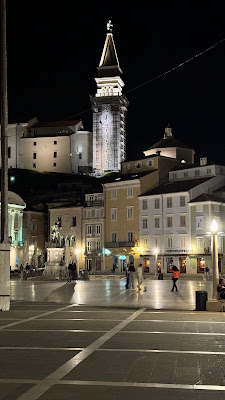The age of knights.
The main living quarters.
The stairs out of the back of the castle up into the caves.
The amazing view from the castle over the valley.

The only seaside town in Slovenia...Piran.

Wednesday, September 25th.
Today was an excellent day. After our buffet breakfast with a group of Slovenian soldiers who were staying at the same hotel, we drove along the banks of the Soca River. We made our way out of Alpine territory to the region and plateau of Primorska. The Soca is a valley of wonderful colours, full of waterfalls, pools, ravines and canyons, with its own distinct flora and fauna. The blue-green Soca River flows over white gravel and through a fairy-tale landscape with a stunning vista at every turn.
We drove for two hours to the Postojna Caves where we had a guided visit. This region was once submerged by a deep sea; today the landscape is characterized by subterranean rivers which have carved out magnificent caves. The cave is 27 km (17 miles) long and over 2 million years old, and consists of a series of caverns, halls and passages with enormous stalactites and stalagmites. The caves also have their own unique ecosystem, flora and fauna; the most famous creature endemic to the caves is the so called Proteus Anguinus, or "human fish", a small pink, blind type of salamander equipped with both gills and rudimentary lungs. I’ve been to a number of different caves around the world but this was a unique experience. We boarded a train that took us for a 10 minute ride for about 12 kms into the cave. From there we disembarked and walked on a paved path through several different areas of the caves all the while passing a myriad of stalactites and stalagmites either growing down from the ceiling or rising up from the floor of the cave. There are also pillars where the drippings from the stalactites eventually meet and attach to the stalagmites. We walked for about 45 minutes past thousands of these amazing formations before arriving at the large aquarium with the cave's famous inhabitant, the blind proteus or olm, which is referred in local lore as baby dragons. They are about a foot long and are the largest cave animal in the world. We were not allowed to take photos as the flash disturbs them and blinds other people around the tank, so I took a photo of a postcard in the souvenir shop.
We had lunch at a cafe there and then drove for about 20 minutes to Predjama Castle, located in the middle of a 123m (403 ft) high, overhanging, limestone cliff, in the entrance of a cave. The castle was built in front of a cave system and attached to the rock formation. It was defended by a drawbridge and the usual castle embattlements, but if the castle was breached the occupants could retreat into the caves behind and pull up another drawbridge to lock them in; but there was a secret exit where they could still get out and plenty of water inside from the cave itself. It's been described as a "masterpiece of medieval ingenuity, courage, cunning and defiance". Its white walls, roofs, turrets and chimneys jutting from the mountainside, built onto solid rock, make it the most unique and picturesque fortress you will ever come across in Europe.
We continue to Piran, on the Istria peninsula, beautifully located on the Adriatic. The town resembles a large open-air museum, with medieval architecture and a rich cultural heritage. Narrow streets and compact houses give the town its special charm. The area is Slovenia’s only access to the Adriatic Sea and although it is Slovenian, most people here speak either Italian or Croatian. We checked into a lovely little hotel and then went for dinner on the harbour and enjoyed a wonderful seafood meal. I had grilled octopus and Shayna had a large bowl of mussels, clams, langustine, scallops and scampi. After dinner a group of us walked around the small town square with Amanda and found an outdoor bar where we had a nightcap.











Such wonderful detail in your writing!! And your phographs are beautiful!!
ReplyDeleteTrip looks amazing !!
Eva